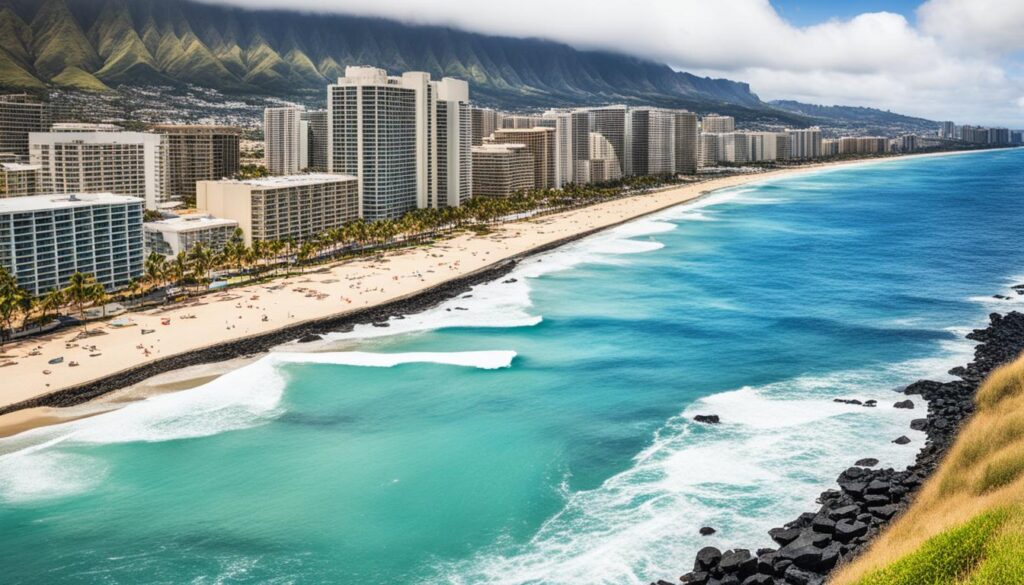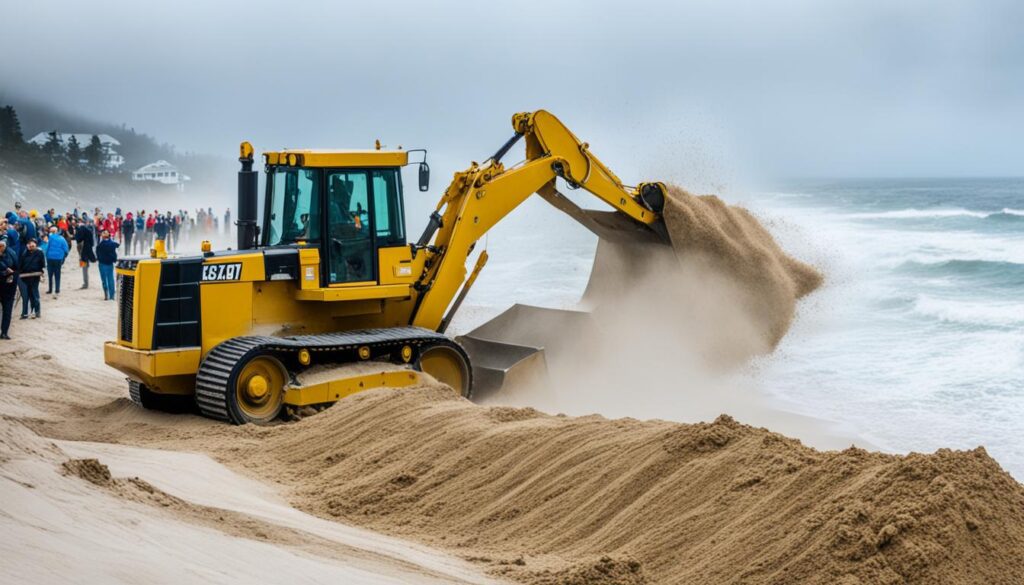A recent study has unveiled a startling truth: over 60% of Waikiki Beach’s shoreline has been lost in the last century. This once vast expanse of golden sand and crystal-clear waters is now under threat from climate change and coastal erosion. These forces are eroding its very essence, casting doubt over its future.
Key Takeaways:
- Waikiki Beach, a renowned Hawaiian landmark, is rapidly disappearing due to the combined effects of sea level rise and coastal erosion.
- Climate change is the primary driver behind this environmental threat, with rising temperatures and increasingly frequent extreme weather events accelerating the loss of this iconic beach.
- The disappearance of Waikiki Beach poses significant challenges to the local economy, which relies heavily on tourism, as well as the overall ecological balance of the region.
- Effective strategies for beach conservation and shoreline management are crucial to preserving Waikiki Beach for future generations.
- Sustainable tourism practices and community-driven initiatives can play a vital role in addressing the complex issues surrounding the vanishing of this Hawaiian treasure.
Waikiki Beach: A Vanishing Gem in Hawaii
Oahu, the most frequented island in Hawaii, houses the renowned Waikiki neighborhood, a pivotal spot for numerous travelers. Yet, the beaches adjacent to Waikiki are experiencing a significant reduction in width, with certain stretches now devoid of sand. High tide or swells often inundate the walkways, drenching those passing by. This distressing phenomenon is anticipated to intensify as coastal erosion and rising sea levels further alter Hawaii’s shoreline.
Coastal Erosion: The Silent Threat
The beaches of Waikiki have been incrementally vanishing, a consequence of the unyielding forces of coastal erosion. This natural phenomenon, hastened by climate change impacts, is eroding the sand and deteriorating the shoreline. Consequently, the beaches have significantly narrowed, positioning the iconic palm trees and resorts perilously near the water’s edge.
Rising Sea Levels: The Relentless Force
The environmental degradation is exacerbated by sea level rise, which is also affecting Waikiki’s beaches. As global ocean levels ascend, the island ecosystems of Hawaii are bearing the brunt. Within two decades, roads, condos, and resorts mere blocks from the ocean could face inundation due to rising groundwater levels.
The metamorphosis of Waikiki’s beaches starkly illustrates the beach loss and shoreline degradation plaguing Hawaii’s coastlines. As these transformations persist, the future of this tropical haven is precarious, prompting both residents and tourists to ponder: is Waikiki Beach disappearing?
Shoreline Hardening: A Double-Edged Sword
Waikiki Beach’s coastal development is expanding, leading to a concerning trend: the widespread use of shoreline hardening. Seawalls and other artificial barriers are erected to shield land and infrastructure from the ocean’s forces. Yet, this strategy has a profound environmental cost.
Shoreline hardening, a prevalent beach management strategy, has worsened coastal erosion on Oahu. At Waikiki Beach’s ends, the ocean has eroded the sand, leaving only water against the seawalls. These structures impede the natural sand flow, causing it to pile up on one side and deplete the other, resulting in beach erosion.
Now, nearly one-third of Oahu’s beaches are hardened, and models forecast that by 2050, nearly 40% could be lost. This trend’s environmental impact is severe, diminishing the coastline’s natural beauty and harming the local ecosystem and marine life.
| Coastal Development Trend | Current Situation | Projected Future |
|---|---|---|
| Shoreline Hardening | 33% of Oahu’s beaches are hardened | 40% of Oahu’s beaches could be lost by 2050 |
Finding a balance between coastal protection and preserving Waikiki Beach’s natural beauty and ecological integrity is crucial. Policymakers and stakeholders must navigate this challenge. A sustainable approach to coastal management is essential to ensure Waikiki Beach’s long-term resilience.

The Economic Impact of Beach Erosion
Hawaii’s tourism economy is deeply linked with its beaches, especially Waikiki Beach. Waikiki Beach generates a massive $7.8 billion in visitor dollars annually. Tourism, accounting for a quarter of Hawaii’s economy, faces severe economic threats from beach erosion. This erosion not only damages the aesthetic appeal but also jeopardizes Hawaii’s prosperity.
Tourism: The Lifeblood of Hawaii
Hawaii attracts visitors with its untouched beaches, lush landscapes, and deep cultural heritage. The tourism sector employs over 200,000 people and contributes billions in taxes, vital to the state’s economy. Any disruption, like Waikiki Beach’s erosion, could severely impact Hawaii’s economy.
Waikiki Beach: A Catalyst for Resilience
Confronting these challenges, Hawaii’s private and public sectors are working together to enhance coastal resilience. They are implementing innovative infrastructure and sustainable tourism practices. This effort aims to protect Waikiki Beach and the livelihoods it supports. By focusing on coastal resilience and economic adaptation, Hawaii is setting a course towards a secure and prosperous future.
Adaptation Strategies for Waikiki Beach
Waikiki Beach, a symbol of Hawaiian allure, now confronts the imperative of climate adaptation with heightened urgency. The Office of Climate Change, Sustainability, and Resiliency has been at the forefront, proactively addressing the challenges this iconic locale faces. Their efforts underscore the critical need for coastal resilience within the community.
Waikiki’s response to these challenges is marked by a unique partnership with the Board of Water Supply and other public entities. This alliance has led to the deployment of sensors in Honolulu’s storm drains. These sensors track the ascension of water levels, enabling a deeper comprehension of the coastal resilience hurdles and the formulation of bespoke solutions.
Innovative Solutions for a Changing Landscape
Waikiki Beach is witnessing a plethora of projects aimed at its preservation and the maintenance of its ecosystem’s fragility. A pivotal initiative is the construction of a groin, a coastal barrier intended to replenish the beach with sand and shield it against the erosive forces of the ocean. This endeavor embodies environmental innovation, striving to bolster beach conservation and foster sustainable development within the locale.
The Waikiki Special Improvement District Association is driving an adaptation blueprint for the neighborhood, venturing into novel ideas. These include elevating Waikiki’s streets to transform them into walkways, permitting water to flow beneath, and constructing additional canals. Such community-centric strategies reflect a comprehensive strategy to confront the climate adaptation challenges besetting Waikiki Beach.
Waikiki Beach stands as a beacon in the global discourse on coastal resilience, underscoring the pivotal role of environmental innovation and community engagement. Through concerted efforts and a dedication to sustainable development, the stakeholders of this revered destination are committed to safeguarding its natural splendor for future generations.
Beach Replenishment: A Temporary Fix
Waikiki Beach, a quintessential Hawaiian destination, confronts a severe challenge: beach erosion. Coastal management entities have embraced beach replenishment, a method known as “sand nourishment.” This entails the vacuuming of sand from offshore areas and its subsequent deposition onto the shoreline. The aim is to enhance the beach’s width and depth.
The primary stretch of Waikiki Beach, adjacent to the renowned Royal Hawaiian Hotel, is entirely man-made. It has historically required regular sand replenishment to preserve its charm. In 2021, 21,700 cubic yards of sand were added to the shoreline. Such replenishment is anticipated to recur every five to ten years, given the coastline’s swift erosion.
Concurrently, coastal managers have implemented the construction of groins and breakwaters to impede sand loss. These structures aim to alter the natural currents and wave patterns, thereby retaining sand on the beach. Yet, these interventions introduce complications, potentially harming the local marine ecosystem.
Despite its temporary benefits, the long-term viability and environmental implications of beach replenishment are contentious. Critics posit that it merely conceals the root cause of coastal erosion, which is worsened by sea level rise and climate change. Hence, the future of Waikiki Beach and Hawaii’s coastal management necessitates a holistic, sustainable strategy.

The waikiki beach disappearing: A Stark Reality
Waikiki Beach, a globally acclaimed vacation spot in Hawaii, confronts a dire situation – its shoreline is swiftly receding. This erosion is attributed to the interplay of waikiki beach erosion, climate change, and coastal development. Government officials and scientists have been meticulously tracking this trend over the last decade.
Dolan Eversole, a coastal geologist and the Waikiki Beach Management Coordinator for the Hawaii Sea Grant Program, highlights the gravity of the situation. He states, “One foot of sea level rise, we can adapt, but four to six feet can be catastrophic.” Experts foresee a four-foot sea level rise necessitating the submersion of nearly half of Waikiki. They anticipate one foot of rise by 2050 and four to six feet by 2100.
The degradation of the environment and the retreat of the shoreline in Waikiki reflect a global trend. Coastal regions worldwide are experiencing the detrimental effects of climate change, coastal development, and erosion. This trend poses a significant threat to the survival of iconic beach destinations. Hence, there is an imperative for comprehensive adaptation strategies and collective action to mitigate the challenges faced by Waikiki Beach and other coastal locales.
| Metric | Projected Value | Timeline |
|---|---|---|
| Sea level rise | 1 foot | 2050 |
| Sea level rise | 4-6 feet | 2100 |
| Waikiki Beach submerged | Nearly 50% | 4 feet of sea level rise |
Ecological Consequences of Beach Erosion
The erosion of Waikiki Beach is causing severe damage to the beach ecosystem and marine life. This iconic Hawaiian shoreline’s erosion endangers the balance of coastal habitats that have existed for generations. The loss of this natural environment is catastrophic.
Marine Life: The Hidden Victims
Many species of marine life depend on the beach for their survival. Sea turtles and endangered Hawaiian monk seals, for example, use beaches to lay eggs and raise their young. The erosion of these habitats puts these species at risk and disrupts the food web that supports the entire ecosystem.
Furthermore, the decline of the beach affects local fishermen’s livelihoods. They rely on the rich marine life in coastal waters for their income. As the beach ecosystem deteriorates, fish populations may decline, impacting the economic and cultural well-being of the community.
The environmental degradation and biodiversity loss due to Waikiki Beach’s erosion are immense. The beach is crucial to Hawaii’s coastal habitats. Its disappearance will have a significant ecological impact, affecting areas far beyond the shoreline.
Indigenous Knowledge: A Path to Resilience
As the world confronts the escalating issues of climate change and environmental degradation, researchers are increasingly exploring an unexpected source of wisdom: the indigenous knowledge of native Hawaiians. These communities have thrived in harmony with their land for centuries, developing sustainable practices that offer valuable insights for modern resource management. Their approach to the environment is a testament to the potential for ecological balance and sustainability.
The traditional land management techniques of native Hawaiians are deeply rooted in a profound respect for the ecosystem’s delicate balance. They cultivate native plant species and manage water resources strategically, demonstrating a profound understanding of the land and its needs. By integrating this indigenous knowledge into contemporary conservation efforts, scientists and policymakers can discover new avenues towards resilience against environmental threats.
Furthermore, the cultural preservation of native Hawaiian traditions acts as a powerful catalyst for sustainable change. The rich cultural heritage of these communities is intricately linked to their environmental stewardship, promoting a holistic approach to resource management. This approach prioritizes both cultural and ecological wellbeing. By embracing and amplifying these traditional practices, we can safeguard the future of Waikiki Beach and beyond.
- Indigenous knowledge offers a wealth of sustainable land management strategies, honed over centuries of living in harmony with the environment.
- Incorporating traditional ecological knowledge can provide valuable insights for building resilience in the face of climate change and environmental threats.
- The cultural preservation of native Hawaiian traditions is inextricably linked to environmental stewardship, fostering a holistic approach to resource management.
As we navigate the complex challenges facing Waikiki Beach and other coastal regions, the wisdom of indigenous communities shines as a guiding light. By adopting the sustainable practices and cultural traditions of native Hawaiians, we can forge a path towards a more resilient and ecologically balanced future.
Sustainable Tourism: A Beacon of Hope
The tourism sector is pivotal in addressing climate change and environmental degradation. In Hawaii, the initiative for regenerative tourism is expanding. It encourages travelers to contribute to the islands’ stewardship and conservation of natural resources.
Eco-Friendly Accommodations: A Step Towards Change
Supporting eco-friendly accommodations in Waikiki Beach is crucial for preserving Hawaii’s beauty and cultural heritage. These establishments focus on social and environmental responsibility. They adopt sustainable practices like renewable energy, water conservation, and efficient waste management. This reduces their environmental impact and showcases a dedication to sustainability.
- Eco-tourism: Embracing a holistic approach to travel that minimizes the impact on the environment and local communities.
- Green hotels: Accommodations that prioritize energy efficiency, water conservation, and sustainable waste management.
- Responsible travel: Making conscious choices to support businesses and activities that align with environmental and social justice principles.
| Sustainable Tourism Practices | Benefits |
|---|---|
| Renewable Energy Utilization | Reduced carbon footprint and energy consumption |
| Water Conservation Measures | Responsible use of a precious natural resource |
| Sustainable Waste Management | Minimizing waste and promoting recycling and composting |
| Local Community Engagement | Preservation of cultural heritage and economic opportunities |
By adopting sustainable tourism practices, visitors to Waikiki Beach can act as guardians of the islands. This approach helps maintain their natural beauty and cultural richness. It highlights the potential for responsible travel to transform Waikiki Beach and Hawaii, offering hope for a sustainable future.
Collaborative Efforts: A Unified Approach
In the face of escalating challenges, Waikiki Beach’s stakeholders have turned to collaborative efforts for coastal resilience and climate adaptation. The Waikiki Special Improvement District Association, founded in 2015, spearheads this initiative. It unites property owners, government entities, and hotels to forge an adaptation plan for the locale.
Currently, the organization is in the visioning phase, deeply engaging with the Waikiki community to collect insights. This approach highlights the pivotal role of community engagement in crafting effective strategies for Waikiki Beach’s pressing issues.
Through public-private partnerships, the Waikiki Special Improvement District Association amalgamates the expertise and resources of varied stakeholders. This synergy is aimed at developing a holistic plan for coastal resilience and climate adaptation. By fostering stakeholder collaboration, the organization endeavors to forge a unified response to the threats menacing this iconic Hawaiian locale.
As climate change’s impacts intensify, Waikiki’s collaborative endeavors stand as a blueprint for other coastal communities. By adopting a comprehensive and inclusive strategy, the Waikiki Special Improvement District Association is setting the stage for a resilient and sustainable future for Waikiki Beach.
| Stakeholder Collaboration | Public-Private Partnerships | Community Engagement |
|---|---|---|
| The Waikiki Special Improvement District Association brings together property owners, government officials, and hotels to develop an adaptation plan. | The organization leverages the expertise and resources of diverse stakeholders to craft a comprehensive plan for coastal resilience and climate adaptation. | The Waikiki Special Improvement District Association actively engages with the local community to gather input and insights, ensuring an inclusive approach. |
- The Waikiki Special Improvement District Association was created in 2015 to focus on the area’s resiliency.
- The organization is working on an adaptation plan for the neighborhood and is in the visioning stage.
- Collaborative efforts between the private and public sectors, as well as with the local community, are crucial for developing effective strategies to address the challenges facing Waikiki Beach.
The Future of Waikiki Beach: A Call to Action
Waikiki Beach, despite its current challenges, presents a promising future. The state has allocated $800,000 for the Waikiki Adaptation Plan, highlighting a commitment to action. This initiative underscores the importance of preserving this iconic Hawaiian locale. Through the integration of indigenous knowledge and innovative solutions, Waikiki Beach can lead in coastal resilience and sustainable development.
For Waikiki Beach’s future, collaboration is key. Stakeholders, including policymakers, conservationists, and the local community, must unite. Together, they must formulate climate action plans that tackle beach preservation and environmental conservation effectively. Such a collective effort will be vital in enhancing community resilience and ensuring Waikiki Beach’s enduring appeal.
The Waikiki Beach’s plight serves as a rallying cry for global action. By showcasing the efficacy of collaborative efforts and sustainable coastal management, it can galvanize global efforts to safeguard our coastlines. Through concerted action, we can guarantee that these natural assets continue to flourish. They will continue to offer immense economic, ecological, and cultural benefits to all who visit and appreciate them.
FAQ
Is Waikiki Beach disappearing?
What is causing the erosion of Waikiki Beach?
What are the economic implications of the loss of Waikiki Beach?
What is being done to address the challenges facing Waikiki Beach?
What are the ecological consequences of the disappearance of Waikiki Beach?
How can sustainable tourism practices help preserve Waikiki Beach?
What is the long-term outlook for Waikiki Beach?

Scott Sweeney is the creator of Virtual Hawaii 360. Scott is a professional marketer and a lifelong Hawaii enthusiast. Scott splits time between Oahu and Dayton, Ohio. In addition to his marketing endevours, he is also a published Ukulele musician.
